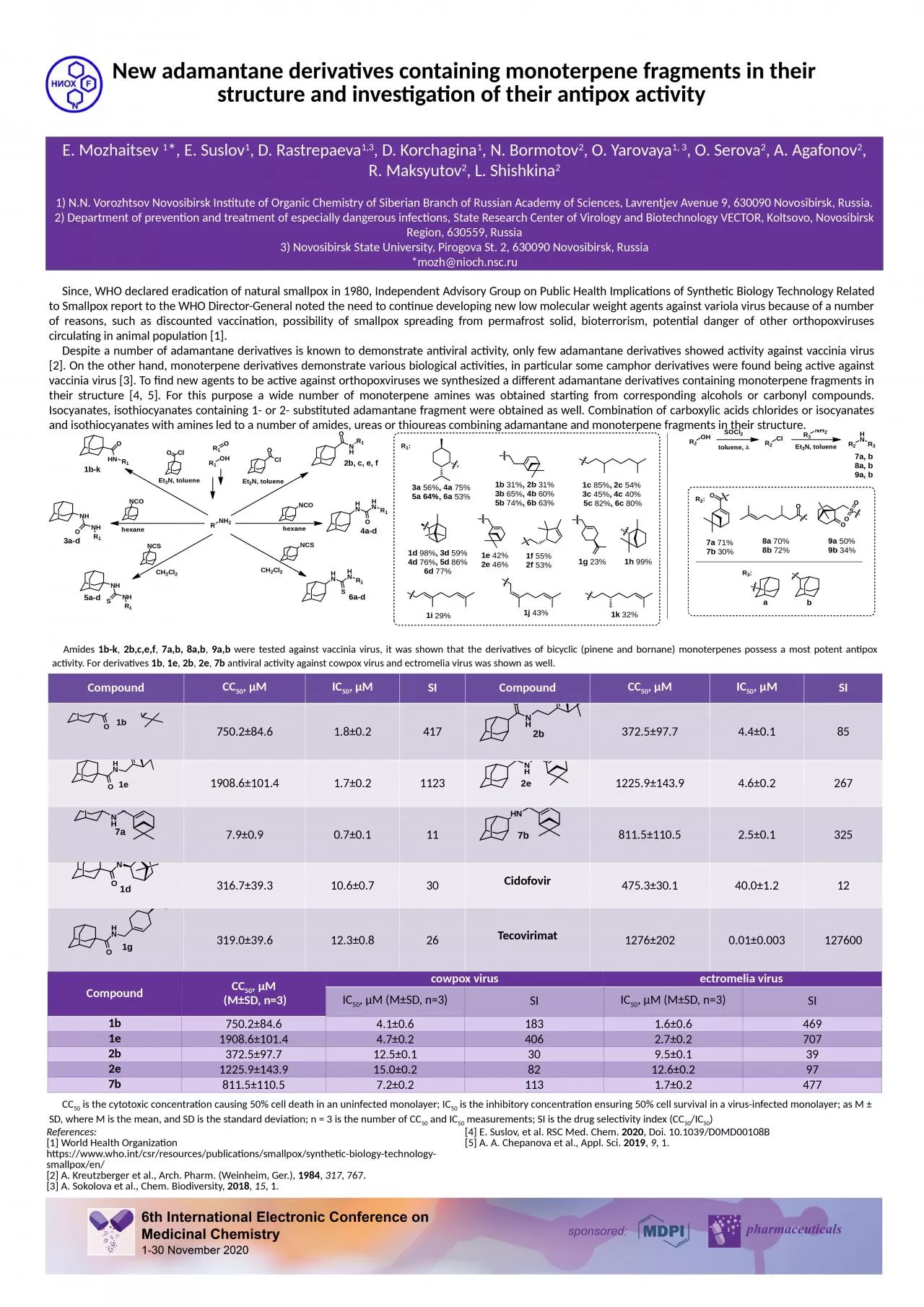

E Mozhaitsev 1 E Suslov 1 D Rastrepaeva 1 3 D Korchagina 1 N Bormotov 2 O Yarovaya 1 3 O Serova 2 A Agafonov 2 R Maksyutov 2 L Shishkina ID: 916929
Download Presentation The PPT/PDF document "New adamantane derivatives containing mo..." is the property of its rightful owner. Permission is granted to download and print the materials on this web site for personal, non-commercial use only, and to display it on your personal computer provided you do not modify the materials and that you retain all copyright notices contained in the materials. By downloading content from our website, you accept the terms of this agreement.
Slide1
New adamantane derivatives containing monoterpene fragments in their structure and investigation of their antipox activity
E. Mozhaitsev 1*, E. Suslov1, D. Rastrepaeva1,3, D. Korchagina1, N. Bormotov2, O. Yarovaya1, 3, O. Serova2, A. Agafonov2, R. Maksyutov2, L. Shishkina21) N.N. Vorozhtsov Novosibirsk Institute of Organic Chemistry of Siberian Branch of Russian Academy of Sciences, Lavrentjev Avenue 9, 630090 Novosibirsk, Russia.2) Department of prevention and treatment of especially dangerous infections, State Research Center of Virology and Biotechnology VECTOR, Koltsovo, Novosibirsk Region, 630559, Russia3) Novosibirsk State University, Pirogova St. 2, 630090 Novosibirsk, Russia*mozh@nioch.nsc.ru
Since, WHO declared eradication of natural smallpox in 1980, Independent Advisory Group on Public Health Implications of Synthetic Biology Technology Related to Smallpox report to the WHO Director-General noted the need to continue developing new low molecular weight agents against variola virus because of a number of reasons, such as discounted vaccination, possibility of smallpox spreading from permafrost solid, bioterrorism, potential danger of other orthopoxviruses circulating in animal population [1].Despite a number of adamantane derivatives is known to demonstrate antiviral activity, only few adamantane derivatives showed activity against vaccinia virus [2]. On the other hand, monoterpene derivatives demonstrate various biological activities, in particular some camphor derivatives were found being active against vaccinia virus [3]. To find new agents to be active against orthopoxviruses we synthesized a different adamantane derivatives containing monoterpene fragments in their structure [4, 5]. For this purpose a wide number of monoterpene amines was obtained starting from corresponding alcohols or carbonyl compounds. Isocyanates, isothiocyanates containing 1- or 2- substituted adamantane fragment were obtained as well. Combination of carboxylic acids chlorides or isocyanates and isothiocyanates with amines led to a number of amides, ureas or thioureas combining adamantane and monoterpene fragments in their structure.
Amides
1b-k
, 2b,c,e,f, 7a,b, 8a,b, 9a,b were tested against vaccinia virus, it was shown that the derivatives of bicyclic (pinene and bornane) monoterpenes possess a most potent antipox activity. For derivatives 1b, 1e, 2b, 2e, 7b antiviral activity against cowpox virus and ectromelia virus was shown as well.
CompoundCC50, µMIC50, µMSICompoundCC50, µMIC50, µMSI750.2±84.61.8±0.2417372.5±97.74.4±0.1851908.6±101.41.7±0.211231225.9±143.94.6±0.22677.9±0.90.7±0.111811.5±110.52.5±0.1325316.7±39.310.6±0.730Cidofovir475.3±30.140.0±1.212319.0±39.612.3±0.826Tecovirimat1276±2020.01±0.003127600
CompoundCC50, µM (М±SD, n=3)cowpox virusectromelia virus IC50, µM (М±SD, n=3)SIIC50, µM (М±SD, n=3)SI1b750.2±84.64.1±0.61831.6±0.64691e1908.6±101.44.7±0.24062.7±0.27072b372.5±97.712.5±0.1309.5±0.1392e1225.9±143.915.0±0.28212.6±0.2977b811.5±110.57.2±0.21131.7±0.2477
CC50 is the cytotoxic concentration causing 50% cell death in an uninfected monolayer; IC50 is the inhibitory concentration ensuring 50% cell survival in a virus-infected monolayer; as M ± SD, where M is the mean, and SD is the standard deviation; n = 3 is the number of CC50 and IC50 measurements; SI is the drug selectivity index (CC50/IC50)
References:[1] World Health Organization https://www.who.int/csr/resources/publications/smallpox/synthetic-biology-technology-smallpox/en/[2] A. Kreutzberger et al., Arch. Pharm. (Weinheim, Ger.), 1984, 317, 767.[3] A. Sokolova et al., Chem. Biodiversity, 2018, 15, 1.[4] E. Suslov, et al. RSC Med. Chem. 2020, Doi. 10.1039/D0MD00108B[5] A. A. Chepanova et al., Appl. Sci. 2019, 9, 1.